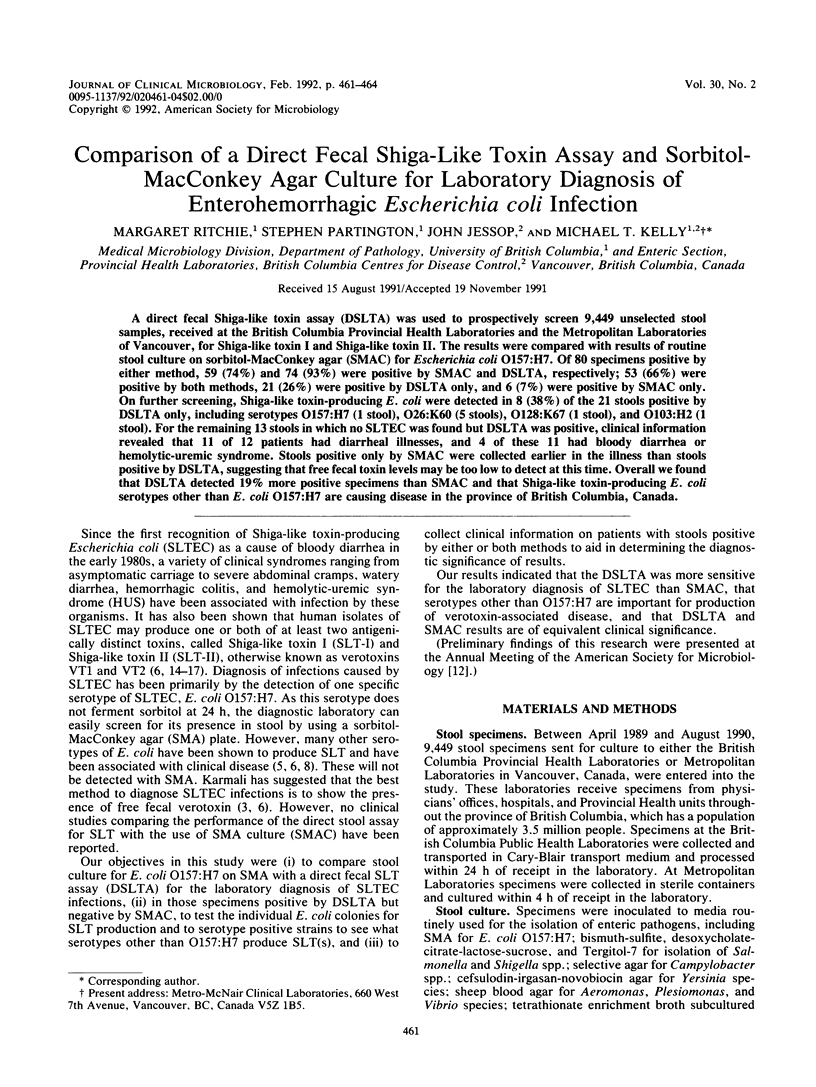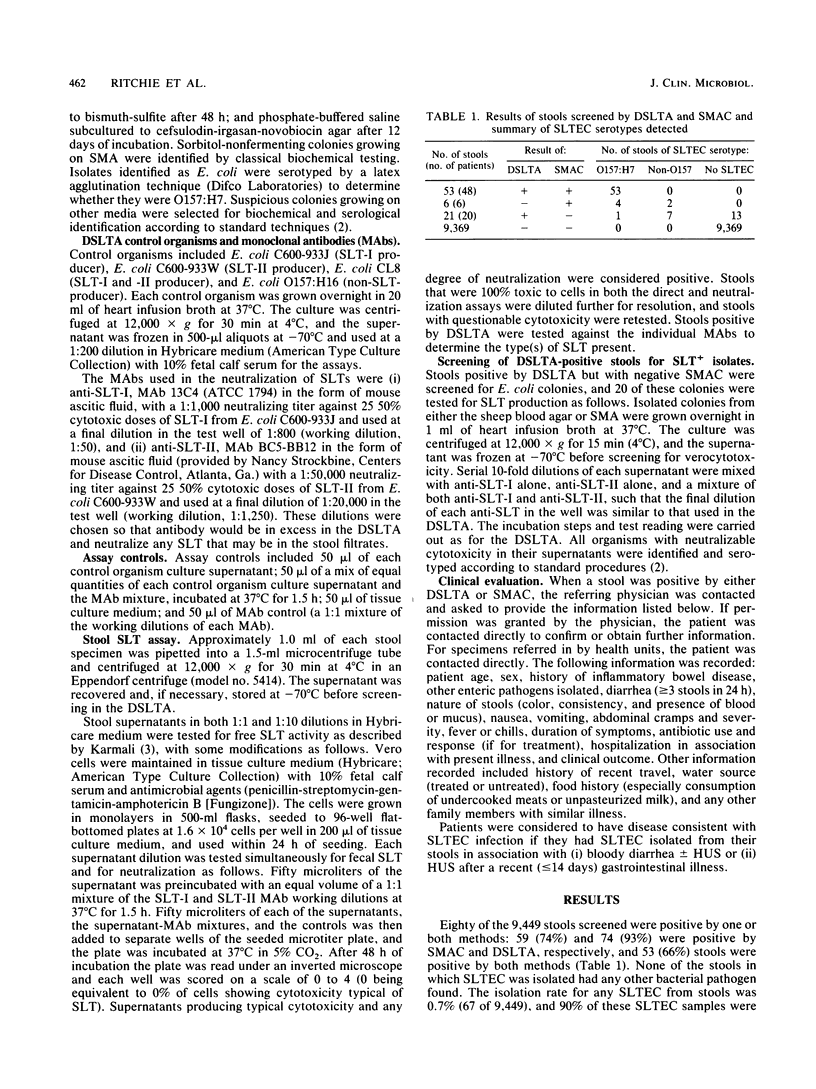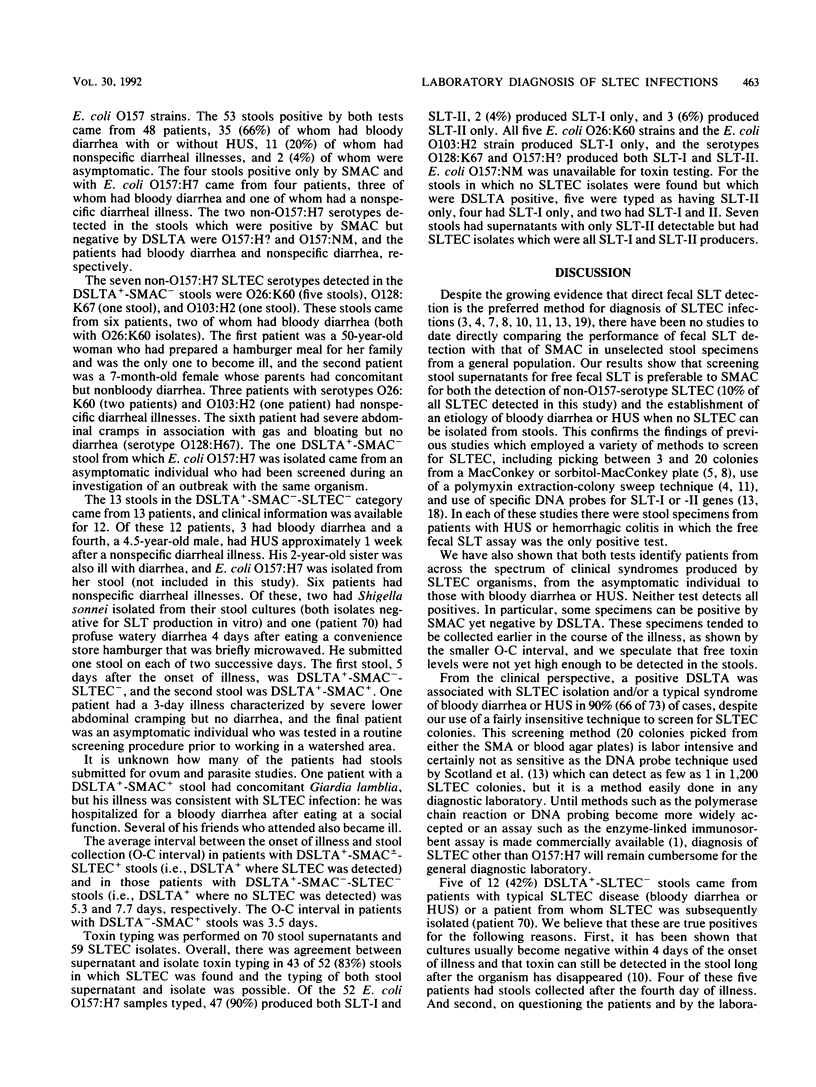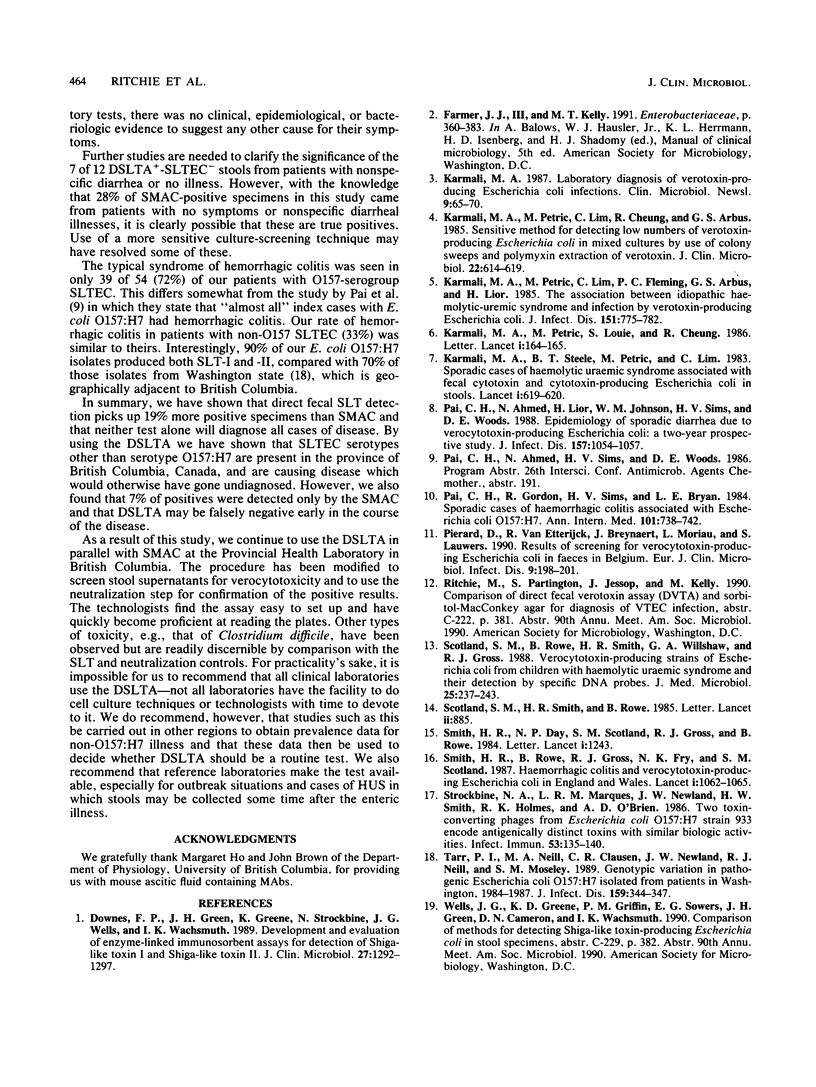Abstract
A direct fecal Shiga-like toxin assay (DSLTA) was used to prospectively screen 9,449 unselected stool samples, received at the British Columbia Provincial Health Laboratories and the Metropolitan Laboratories of Vancouver, for Shiga-like toxin I and Shiga-like toxin II. The results were compared with results of routine stool culture on sorbitol-MacConkey agar (SMAC) for Escherichia coli O157:H7. Of 80 specimens positive by either method, 59 (74%) and 74 (93%) were positive by SMAC and DSLTA, respectively; 53 (66%) were positive by both methods, 21 (26%) were positive by DSLTA only, and 6 (7%) were positive by SMAC only. On further screening, Shiga-like toxin-producing E. coli were detected in 8 (38%) of the 21 stools positive by DSLTA only, including serotypes O157:H7 (1 stool), O26:K60 (5 stools), O128:K67 (1 stool), and O103:H2 (1 stool). For the remaining 13 stools in which no SLTEC was found but DSLTA was positive, clinical information revealed that 11 of 12 patients had diarrheal illnesses, and 4 of these 11 had bloody diarrhea or hemolytic-uremic syndrome. Stools positive only by SMAC were collected earlier in the illness than stools positive by DSLTA, suggesting that free fecal toxin levels may be too low to detect at this time. Overall we found that DSLTA detected 19% more positive specimens than SMAC and that Shiga-like toxin-producing E. coli serotypes other than E. coli O157:H7 are causing disease in the province of British Columbia, Canada.
Full text
PDF



Selected References
These references are in PubMed. This may not be the complete list of references from this article.
- Downes F. P., Green J. H., Greene K., Strockbine N., Wells J. G., Wachsmuth I. K. Development and evaluation of enzyme-linked immunosorbent assays for detection of shiga-like toxin I and shiga-like toxin II. J Clin Microbiol. 1989 Jun;27(6):1292–1297. doi: 10.1128/jcm.27.6.1292-1297.1989. [DOI] [PMC free article] [PubMed] [Google Scholar]
- Karmali M. A., Petric M., Lim C., Cheung R., Arbus G. S. Sensitive method for detecting low numbers of verotoxin-producing Escherichia coli in mixed cultures by use of colony sweeps and polymyxin extraction of verotoxin. J Clin Microbiol. 1985 Oct;22(4):614–619. doi: 10.1128/jcm.22.4.614-619.1985. [DOI] [PMC free article] [PubMed] [Google Scholar]
- Karmali M. A., Petric M., Lim C., Fleming P. C., Arbus G. S., Lior H. The association between idiopathic hemolytic uremic syndrome and infection by verotoxin-producing Escherichia coli. J Infect Dis. 1985 May;151(5):775–782. doi: 10.1093/infdis/151.5.775. [DOI] [PubMed] [Google Scholar]
- Karmali M. A., Petric M., Louie S., Cheung R. Antigenic heterogeneity of Escherichia coli verotoxins. Lancet. 1986 Jan 18;1(8473):164–165. doi: 10.1016/s0140-6736(86)92307-x. [DOI] [PubMed] [Google Scholar]
- Karmali M. A., Steele B. T., Petric M., Lim C. Sporadic cases of haemolytic-uraemic syndrome associated with faecal cytotoxin and cytotoxin-producing Escherichia coli in stools. Lancet. 1983 Mar 19;1(8325):619–620. doi: 10.1016/s0140-6736(83)91795-6. [DOI] [PubMed] [Google Scholar]
- Pai C. H., Ahmed N., Lior H., Johnson W. M., Sims H. V., Woods D. E. Epidemiology of sporadic diarrhea due to verocytotoxin-producing Escherichia coli: a two-year prospective study. J Infect Dis. 1988 May;157(5):1054–1057. doi: 10.1093/infdis/157.5.1054. [DOI] [PubMed] [Google Scholar]
- Pai C. H., Gordon R., Sims H. V., Bryan L. E. Sporadic cases of hemorrhagic colitis associated with Escherichia coli O157:H7. Clinical, epidemiologic, and bacteriologic features. Ann Intern Med. 1984 Dec;101(6):738–742. doi: 10.7326/0003-4819-101-6-738. [DOI] [PubMed] [Google Scholar]
- Piérard D., Van Etterijck R., Breynaert J., Moriau L., Lauwers S. Results of screening for verocytotoxin-producing Escherichia coli in faeces in Belgium. Eur J Clin Microbiol Infect Dis. 1990 Mar;9(3):198–201. doi: 10.1007/BF01963837. [DOI] [PubMed] [Google Scholar]
- Scotland S. M., Rowe B., Smith H. R., Willshaw G. A., Gross R. J. Vero cytotoxin-producing strains of Escherichia coli from children with haemolytic uraemic syndrome and their detection by specific DNA probes. J Med Microbiol. 1988 Apr;25(4):237–243. doi: 10.1099/00222615-25-4-237. [DOI] [PubMed] [Google Scholar]
- Scotland S. M., Smith H. R., Rowe B. Two distinct toxins active on Vero cells from Escherichia coli O157. Lancet. 1985 Oct 19;2(8460):885–886. doi: 10.1016/s0140-6736(85)90146-1. [DOI] [PubMed] [Google Scholar]
- Smith H. R., Day N. P., Scotland S. M., Gross R. J., Rowe B. Phage-determined production of vero cytotoxin in strains of Escherichia coli serogroup O157. Lancet. 1984 Jun 2;1(8388):1242–1243. doi: 10.1016/s0140-6736(84)91729-x. [DOI] [PubMed] [Google Scholar]
- Smith H. R., Rowe B., Gross R. J., Fry N. K., Scotland S. M. Haemorrhagic colitis and Vero-cytotoxin-producing Escherichia coli in England and Wales. Lancet. 1987 May 9;1(8541):1062–1065. doi: 10.1016/s0140-6736(87)90485-5. [DOI] [PubMed] [Google Scholar]
- Strockbine N. A., Marques L. R., Newland J. W., Smith H. W., Holmes R. K., O'Brien A. D. Two toxin-converting phages from Escherichia coli O157:H7 strain 933 encode antigenically distinct toxins with similar biologic activities. Infect Immun. 1986 Jul;53(1):135–140. doi: 10.1128/iai.53.1.135-140.1986. [DOI] [PMC free article] [PubMed] [Google Scholar]
- Tarr P. I., Neill M. A., Clausen C. R., Newland J. W., Neill R. J., Moseley S. L. Genotypic variation in pathogenic Escherichia coli O157:H7 isolated from patients in Washington, 1984-1987. J Infect Dis. 1989 Feb;159(2):344–347. doi: 10.1093/infdis/159.2.344. [DOI] [PubMed] [Google Scholar]


